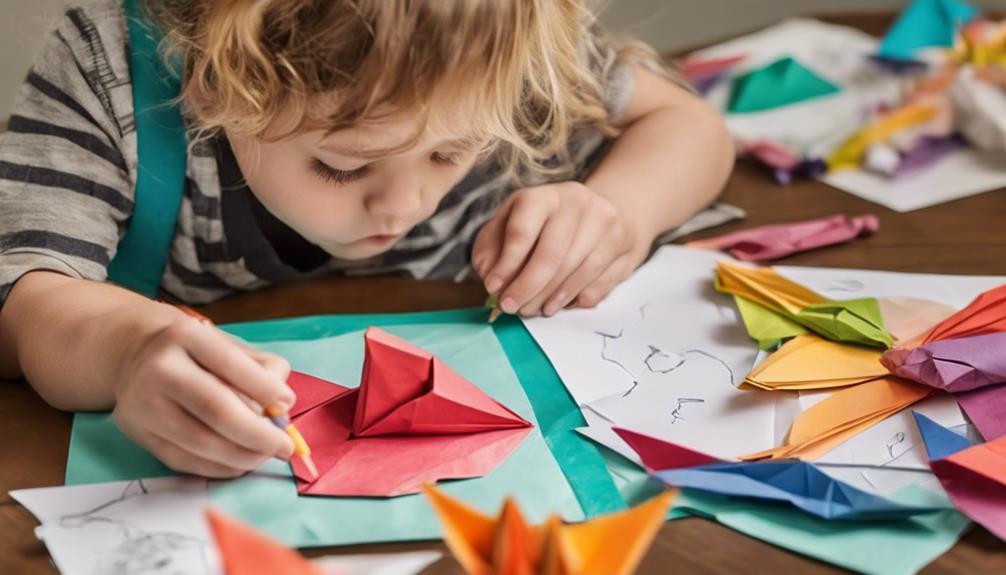Seeing the world through our child's eyes helps us understand their individual struggles and triumphs. When it comes to reading, let's observe their behavior and emotions, identifying signs like frustration. For math difficulties, we can encourage a positive mindset and incorporate engaging activities. Writing challenges may need us to break tasks into smaller steps and celebrate small victories. Addressing attention issues involves creating a distraction-free zone and using visual aids. For organization problems, we can establish clear routines and use tools like planners. By approaching these challenges with empathy and tailored support, we'll better help our child succeed in their daily life.
Key Takeaways
- Observe and empathize with their struggles to better understand their perspective and emotions.
- Engage in activities and games that align with their interests to build a positive learning environment.
- Use visual aids and clear routines to help them navigate tasks and stay organized.
- Break down tasks into manageable steps to prevent overwhelm and encourage progress.
- Provide consistent positive reinforcement and celebrate small victories to boost their confidence.
Observing Reading Struggles
Let's explore how we can better observe and understand our child's reading struggles. As we navigate family life, it's vital to connect with our family members, especially our children, to recognize the challenges they face with reading. By paying close attention to their behavior and emotions, we can identify signs of difficulty, such as hesitancy, frustration, or avoidance when it comes to reading tasks.
Julie Washington's expert insights highlight the importance of empathy. By listening to our child's experiences, we can gain a clearer picture of their struggles. Watching videos where kids share their firsthand accounts can be eye-opening, helping us understand the emotional impact of these challenges. It's crucial to approach these situations with patience and support, offering reassurance and understanding.
We can also use practical tips from experts to tailor our support to our child's needs. This might include setting aside dedicated reading time, choosing books that interest them, or breaking down reading tasks into manageable steps.
Understanding Math Difficulties

Recognizing and addressing math difficulties in children requires both empathy and practical strategies. When young children struggle with math, it can impact their confidence and overall learning experience. Michèle Mazzocco emphasizes that we need to understand the emotional toll these challenges can take. By seeing the world through their eyes, we can better support them.
Here are four ways we can help:
- Encourage a Positive Mindset: Reminding children that it's okay to make mistakes and that effort leads to improvement can build resilience.
- Use Practical Strategies: Incorporate games and hands-on activities that make math fun and relatable.
- Be Patient and Empathetic: Recognize their frustration and offer reassurance, showing that we believe in their abilities.
- Create a Supportive Environment: Establish a routine that includes regular, short practice sessions to build skills gradually.
Navigating Writing Challenges

Children often face frustration and struggle when tackling writing challenges, but with the right support, we can help them overcome these obstacles. As a family, we've a unique vantage point for seeing the world through our child's eyes, especially when it comes to understanding the emotional impact of writing difficulties. It's important to recognize that these struggles can greatly affect their confidence and self-esteem.
To navigate these challenges, we can utilize expert advice and practical tips to support our children. Encouraging them to express their feelings about writing can be a good starting point. We can also break down writing tasks into smaller, more manageable steps, making the process less overwhelming.
Additionally, creating a supportive environment at home is essential. Celebrating small victories and providing positive reinforcement builds confidence in their writing abilities. Family members can take turns reading and discussing each other's writing, transforming it into a fun, collaborative activity.
Addressing Attention Issues

Addressing attention issues directly can greatly enhance our child's ability to focus and thrive in their tasks. As parents, we need to understand and empathize with the struggles our children face. Expert insights from Ned Hallowell suggest that creating a supportive environment is essential. By promoting understanding and acceptance, we can help our children overcome their attention challenges.
To better support our children, let's focus on these four strategies:
- Create a distraction-free zone: A quiet, organized space can markedly reduce distractions, helping our child concentrate better.
- Break tasks into smaller steps: Large tasks can be overwhelming, so breaking them down into manageable parts can make a big difference in maintaining focus.
- Use visual aids: Visual cues like charts, lists, and colorful reminders can help our child stay on track and remember their tasks.
- Encourage regular breaks: Short, frequent breaks can help prevent burnout and keep our child's mind fresh and engaged.
Tackling Organization Problems

While enhancing attention can greatly benefit our child, we must also address their organization problems to ensure they thrive in multiple aspects of life. When children struggle with keeping track of belongings, following routines, and managing time, it affects their academic performance and social interactions. To help them, we should see the world through their eyes and simplify things as much as possible.
Creating visual schedules can be a game-changer. By laying out their day in a clear, visual format, children can better understand what to expect and what's expected of them. Clear routines also provide structure that children with organization challenges desperately need. Whether it's a morning checklist or a bedtime routine, consistency is key.
We can also introduce organizational tools like planners, bins, and labels. These simple things can make a world of difference in helping them manage their belongings and time effectively. Supporting our child in these ways not only aids their daily functioning but also helps them develop life skills essential for future success.
Frequently Asked Questions
What Does It Mean to See the World Through the Eyes of a Child?
Seeing the world through a child's eyes means embracing their curiosity, joy, and simplicity. It involves engaging in sensory activities, marveling at everyday wonders, and letting go of stress. By doing so, we foster mindfulness, gratitude, and deeper family connections.
It also means promoting playfulness, creativity, and a positive outlook, which enhances our emotional well-being and helps us prioritize what truly matters in life.
What Is the Quote About Seeing Life Through a Child's Eyes?
The quote about seeing life through a child's eyes is like discovering a treasure chest of endless wonders. It urges us to adopt a child's perspective, appreciating the simplicity and beauty in everyday moments.
How Does a Child View the World?
Children view the world with awe and curiosity, finding joy in simple things like nature and play. They see it as a vast playground, full of new and exciting possibilities, and their perspective is shaped by immediate experiences and emotions.
Kids feel smaller and less powerful, making our assistance essential. By understanding their view, we can empathize better, fostering a deeper connection and helping them navigate life's discoveries.
What Is a Toddler's View of the World?
A toddler's view of the world is one of endless curiosity and sensory exploration. They experience everything through touch, sight, sound, and taste, constantly discovering new wonders.
Toddlers see us as role models, mimicking our behaviors and expressions. Their immediate needs and desires shape their actions, often expressed through emotions.
Our guidance and interactions greatly influence their understanding and perception, making our role vital in their development.
Conclusion
By seeing the world through our child's eyes, we can better understand and support their unique challenges.
Whether it's reading struggles, math difficulties, writing issues, attention concerns, or organization problems, our empathy and proactive involvement make a difference.
Let's be their guiding light, illuminating the path with patience and encouragement, ensuring they don't feel alone.
Together, we can transform these hurdles into stepping stones, fostering resilience and confidence in our children.








